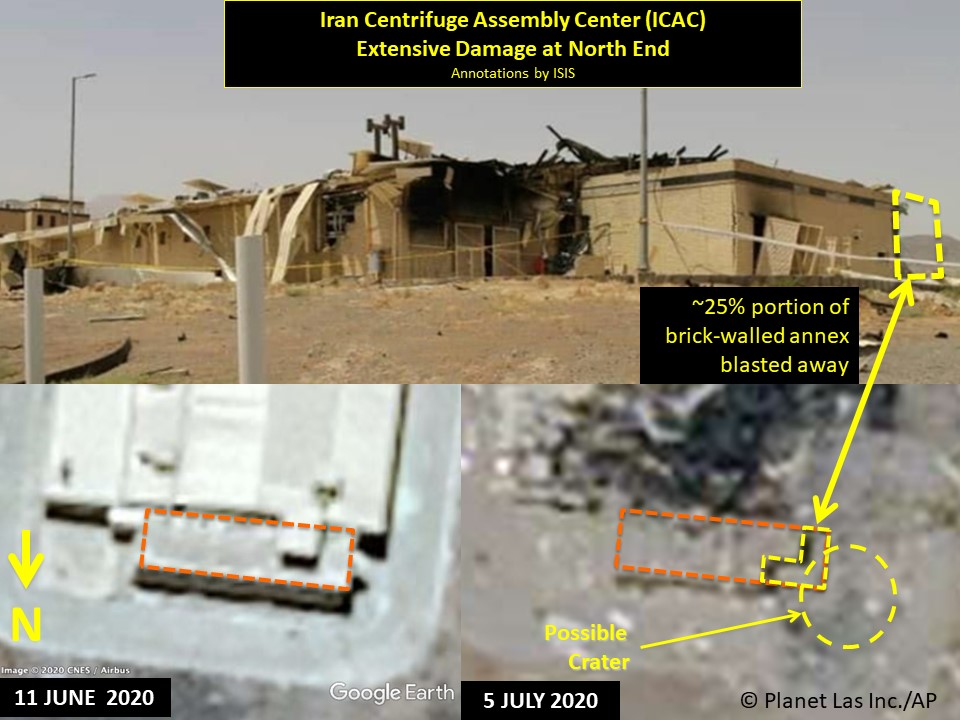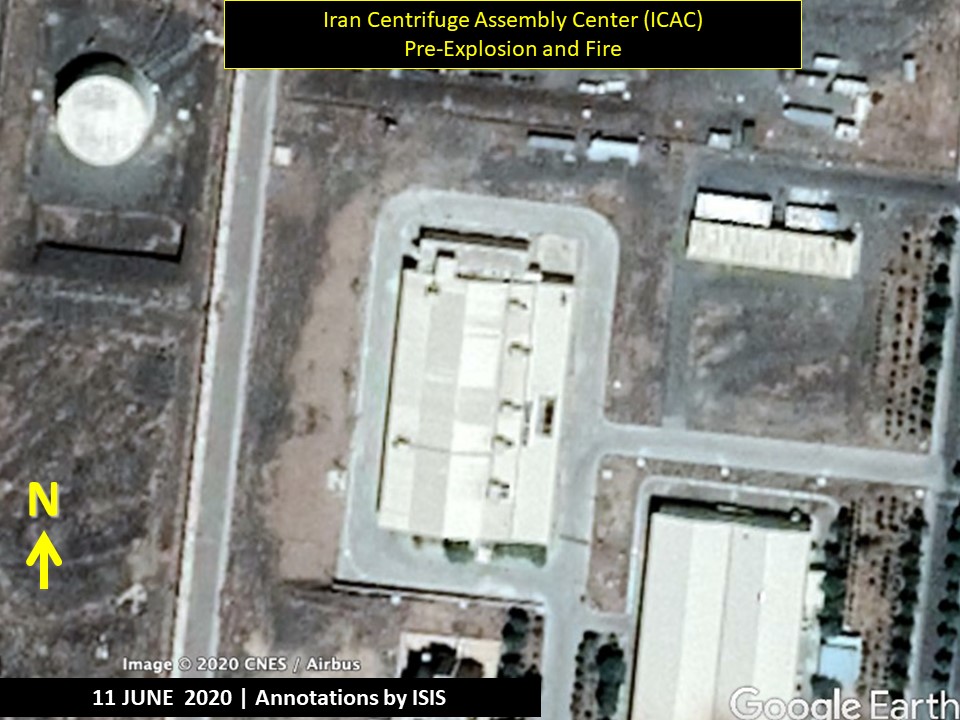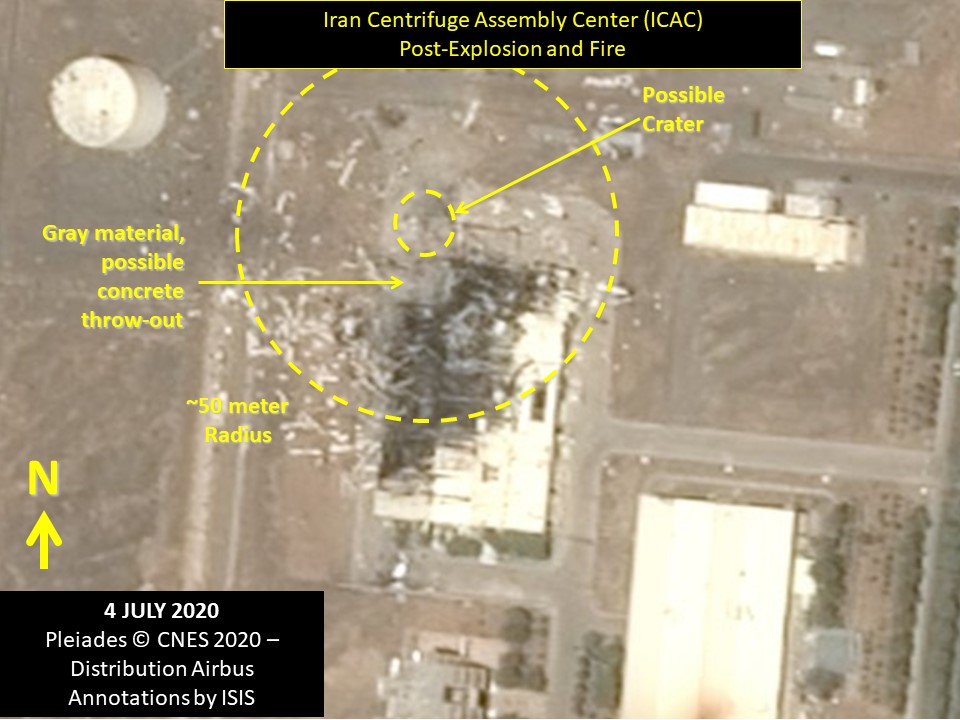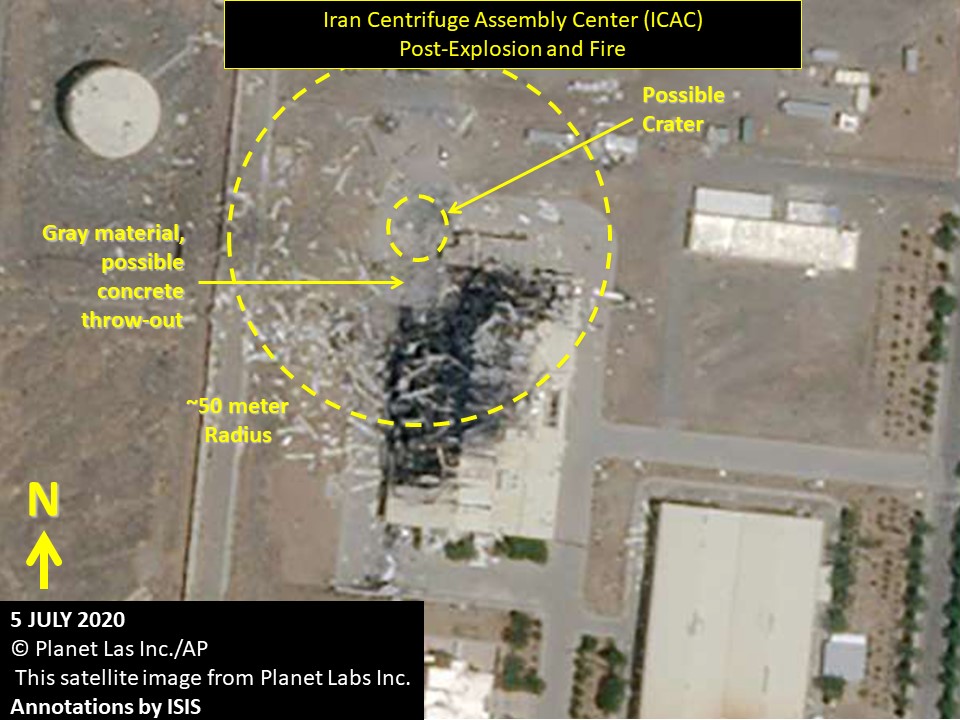Reports
Damage to the Iran Centrifuge Assembly Center (ICAC) at Natanz Is Far More Severe and Extensive Than Previously Reported
by David Albright, Sarah Burkhard, and Frank Pabian
July 8, 2020
High-resolution commercial satellite imagery from July 4 and 5, 2020, shows that the Iran Centrifuge Assembly Center (ICAC) at the Natanz Enrichment Site has suffered significant, extensive, and likely irreparable, damage to its main assembly hall section. This new facility, inaugurated in 2018, was critical to the mass production of advanced centrifuges, in particular the assembly of rotor assemblies, the rapidly spinning part of the centrifuge and its most crucial component. An annex to the building was intended to assemble electrical components of centrifuges, including motors, another important component of centrifuges. While early reporting from Iran suggested that a fire was “limited” and restricted to a “shed under construction,” more recent Iranian admissions are stating that the damage was “significant.”1
Satellite imagery further shows that the damage appears to have been caused by a large single point detonation, possibly creating a crater that is centered at the northwest corner of the ICAC. That explosion, evidently causing or coinciding with a fire, may well have involved an explosives device (that is also consistent with other open source reporting2).
In our previous report,3 our assessment of the extent of the damage was limited to that which could be gleaned only from a single ground image published by the Iranian national media and a short video posted on Youtube by Iribnews.4 In both cases, the images were restricted to showing only the north and east sides of the ICAC. While those images were sufficient to determine that both an explosion and fire had occurred in the building, the building appeared to have remained largely intact, albeit it with significant structural damage. The true extent of the damage was publicly withheld by Iran, either inadvertently or by intent.
It was not until commercial satellite imagery became available that the true nature of the damage could be observed. In the images now available to the Institute, a July 4 image from Airbus/CNES, and a July 5 image by Planet Labs, it is clear that a major explosion took place, destroying nearly three quarters of the main centrifuge assembly hall, generating a fire that blackened a major portion of the building, the blackening visible where the roof had been blown away by the explosion. Although we had originally concluded, based on the ground imagery, that the explosion and fire had most likely occurred in the northeast corner of the building in an area of the building that likely contained auxiliary diesel generators, it is now clear from the overhead satellite imagery that the explosion was actually centered at the northwest corner. Figures 1 – 3 contain overhead imagery of the building before and after the explosion. Unlike the northeast corner, which was blackened by fire and exhibited signs of some structural damage, the northwest corner of the ICAC building, including a large portion of a brick-walled annex, was completely obliterated. Moreover, a debris field of building materials (primarily roofing panels) is also distributed in a roughly radial pattern, extending to a radius of over half a football field, from that same point. What we perceive might be a crater, roughly 10 meters in diameter, is visible in the center of that circular pattern (see Figures 4 – 6). What appears to be some gray concrete throw-out material is also visible in the area where the corner of the building had been. That center-point of the possible crater is located just outside the building, which would be accessible by vehicle, suggesting that a vehicle-borne explosives device cannot be ruled out at this time (see Figure 7).
How significant was the damage?
Based on the record of observable evidence provided by commercial satellite imagery, it is now readily discernable that the extent and severity of the structural damage was indeed significant, as Iran now admits.
The visible damage is such that the entire building will likely have to be razed and re-built from scratch. Advanced centrifuge rotor assemblies are typically assembled in “clean rooms,” an expensive-to-build environment free from dust and other contaminants. A 2018 video shows what appear to be clean rooms in this facility; 5 rebuilding these clean rooms will inevitably add to the time and difficulty of replacing this facility. We might also expect that much of the sensitive equipment, including balancing machines, specialized rotor assembly equipment, measuring equipment, and centrifuge test stands, are also largely unsalvageable. The explosion may have destroyed any contents of what must be a large storeroom for sensitive centrifuge components and many rotor assemblies; the latter would await deployment in enrichment plants. Overall, this event is a significant setback for the Iranian advanced gas centrifuge production and operations effort.
The building’s replacement would be expected to take at least a year, if not longer. Its construction stretched over several years, having started in 2012, roughly six years before it was announced operational in June 2018.
This explosion will not likely affect Iran’s near-term research and development of centrifuges at the nearby Natanz Pilot Fuel Enrichment Plant (PFEP). Iran has other facilities that assemble advanced centrifuges for R&D, such as Kalaye Electric, a facility in north Tehran which assembles the IR-8 centrifuge and perhaps other ones as well. There may be additional small-scale assembly operations at Natanz and/or elsewhere.
However, the explosion was a significant setback to Iran’s plans and ability to mass produce advanced centrifuges, boasted about in the press in 2017 and in the 2018 Iribnews video.6 As far as we can ascertain, the Natanz centrifuge assembly building was the only clean room operation set up for mass assembly of advanced centrifuges. Based on information about the plant’s design, mass assembly would correspond to several thousand advanced centrifuges per year.
Advanced Centrifuge Deployments at Natanz and Fordow Fuel Enrichment Plants (FEPs)?
Following its January 2020 announcement renouncing its Joint Comprehensive Plan of Action (JCPOA) commitment limiting the number and type of centrifuges deployed at these two sites, Iran has been expected to deploy large numbers of advanced centrifuges at the Natanz and perhaps the Fordow Fuel Enrichment Plants. These deployments likely would have depended on the ICAC and thus are likely delayed for the near-to-medium term.
What centrifuges could be affected? As discussed above, this explosion may have only minimal impact on the R&D program at the Natanz pilot plant. But deployments in underground FEPs will likely be impacted. A 2018 Iranian video shows a room inside of the assembly building, identified in the 2018 Iribnews video as the main assembly room; visible are what appear to be outer casings of IR-2m, IR-4 and IR-6 centrifuges, 7 possibly part of mechanical test stands used in the final testing of assembled rotor assemblies, prior to shipping the rotor assemblies off to an enrichment site for installation into centrifuge cascades.8 The first two, the IR-2m and IR-4 centrifuges, and possibly some of the variants of the IR-6 centrifuge are the models most ready to be deployed on a production-scale. It should be noted, however, that the IR-6 centrifuge models do not appear to have been fully tested in the pilot enrichment plant, meaning their mass production may not in fact have been imminent.
A caveat is that Iran had disassembled and stored approximately 1000 IR-2m centrifuges prior to 2016 as a result of the JCPOA, and it may have hidden an undetermined, but possibly equal, number of IR-2m centrifuges in various states of production. The 1000 centrifuges were stored at the Natanz FEP and could be redeployed at the Natanz or Fordow FEPs, following a set of actions, requiring skilled workmen, but not requiring the equipment or expertise in the ICAC. Nevertheless, the current status of these IR-2m centrifuges is unknown, as well as any plans for their redeployment. Reports state that another centrifuge model, the IR-8, has failed. Several other of Iran’s centrifuge models likewise appear unready for mass production.
The ICAC was also involved in assembling other centrifuge components, according to an expert. An annex to this building reportedly was planned for assembling centrifuge motors and ancillary equipment. The 230 meter square annex is located at the back of the building (see Figure 7), where approximately one quarter of the annex was razed by the blast.
Conclusion
The centrifuge assembly building was reportedly intended to mass produce IR-2m, IR-4, and IR-6 centrifuges. Mass production translates to the combined production of thousands of such centrifuges per year. Although the explosion and fire at the Iran Centrifuge Assembly Center does not eliminate Iran’s ability to deploy advanced centrifuges, such as the IR-2m’s, its destruction must be viewed as a major setback to Iran’s ability to deploy advanced centrifuges on a mass scale for years to come.
Figure 1. The ICAC Building as it appeared in this June 11, 2020 CNES/Airbus satellite image as found on Google Earth.
Figure 2. The ICAC Building as it appeared in this July 4, 2020 CNES/Airbus satellite image acquired the day after the explosion and fire.
Figure 3. The ICAC Building as it appeared in this July 5, 2020 Planet Labs satellite image as published by CNN and AP.

Figure 4. The ICAC Building as it appeared in this June 11, 2020 CNES/Airbus satellite image as found on Google Earth showing the subsequent location of a possible crater and the approximate blast and damage area from the explosion and fire.
Figure 5. The ICAC Building as it appeared in this July 4, 2020 CNES/Airbus satellite image acquired the day after the explosion and fire, showing the location of a possible crater and the approximate blast and damage area from the explosion and fire.
Figure 6. The ICAC Building as it appeared in this July 5, 2020 Planet Labs satellite image as published by CNN and AP, showing the location of a possible crater and the approximate blast and damage area from the explosion and fire.

1. Nick Patan Walsh, “Mystery fire at Iranian nuclear facility is the latest in a series of unexplained incidents,” CNN, July 6, 2020, https://edition.cnn.com/2020/07/06/middleeast/iran-nuclear-plant-fire-analysis-intl/index.html; “Accident Happens in Iran’s Natanz Nuclear Site,” Tasnim News Agency, July 2, 2020, https://www.tasnimnews.com/en/news/2020/07/02/2298220/accident-happens-in-iran-s-natanz-nuclear-site ↩
2. Farnaz Fasihi, Richard Pérez-Peña, and Ronen Bergman, “Iran Admits Serious Damage to Natanz Nuclear Site, Setting Back Program, The New York Times, July 5, 2020, https://www.nytimes.com/2020/07/05/world/middleeast/iran-Natanz-nuclear-damage.html ↩
3. David Albright, Sarah Burkhard, and Frank Pabian, “Mysterious Fire and Explosion in the New Natanz Advanced Centrifuge Assembly Facility,” Institute for Science and International Security, July 3, 2020, https://isis-online.org/isis-reports/detail/fire-and-explosion-in-the-new-natanz-centrifuge-assembly ↩
4. Iribnews, “Natanz nuclear site ready to produce, assemble and install a new generation of nuclear centrifuges,” June 7, 2018, https://www.youtube.com/watch?v=zMJ8wnH5QlE (in Farsi, title translated using Google Translate). ↩
5. Iribnews, “Natanz nuclear site ready to produce, assemble and install a new generation of nuclear centrifuges.” ↩
6. David Albright and Olli Heinonen, “Is Iran Mass Producing Advanced Gas Centrifuge Components?” Institute for Science and International Security, May 30, 2017 (revised on May 31, 2017) https://isis-online.org/isis-reports/detail/fire-and-explosion-in-the-new-natanz-centrifuge-assembly ↩
7. Iribnews, “Natanz nuclear site ready to produce, assemble and install a new generation of nuclear centrifuges.” ↩
8. Based on Iran’s practices at Natanz in the past, the rotor assemblies would be shipped to an Iranian enrichment plant, where in parallel centrifuge cascades have been constructed, including the installation of the outer casings. The rotor assemblies would be inserted into the outer casings that are already in place, followed by finishing installing the centrifuges and bringing the cascade under vacuum. ↩






 twitter
twitter